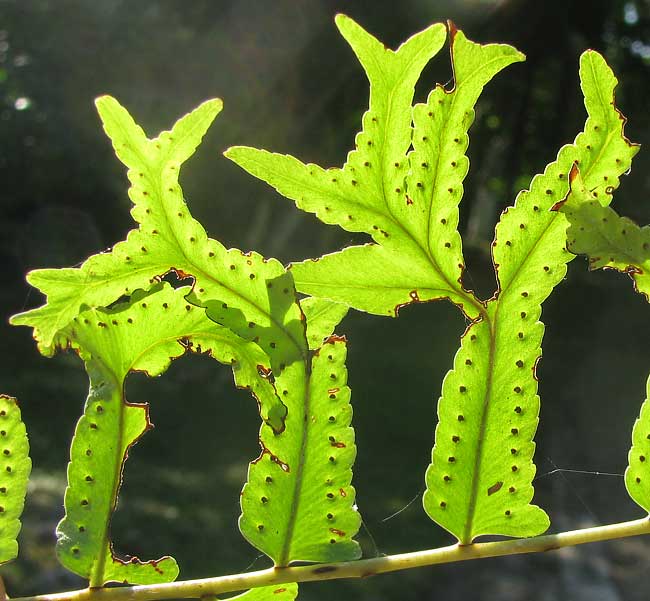Excerpts from Jim Conrad's
Naturalist Newsletter

from the January 3, 2010 Newsletter issued from Hacienda Chichen Resort beside Chichén Itzá Ruins, central Yucatán, MÉXICO; limestone bedrock, elevation ~39m (~128ft), ~N20.676°, ~W88.569°
FISHTAIL SWORDFERN
Can you figure out what you're seeing above?
The picture shows two pinnae of a fern frond, a pinna being the frond's primary or "final" division. It's like the smallest division of a compound leaf. The dots along the margins are sori, which are clusters of tiny, baglike sporangia filled with spores. We've seen lots of frond pinnae with sori during our wanderings but none like this. These pinnae are remarkable because they're forked and then the fork branches fork again.
One name this fern goes by is Fishtail Swordfern. It's NEPHROLEPIS FALCATA. Its exact origin is unknown but some experts suppose that it's a mutant cultivar that arose from the Giant Swordfern, Nephrolepis biserrata, which grows wild in the tropics worldwide and is much planted. The Fishtail mutant occurs only under cultivation and where it's escaped locally from cultivation.
A close-up of three old sori along the margin is below:

It's clear that these are old because the baglike sporangia already have split open, released their spores and themselves have fallen off, leaving only sporangia stumps. The picture is worth seeing, however, because it shows the unusual way the cellophane-like sori covering, the indusium, arises all around each sorus, like a ruffled placemat beneath a pile of grapes. Usually indusia, if present at all, arise along one side of a sorus, not like a bowl beneath it like this.
Fishtail Swordfern is planted in tropical gardens worldwide. It's a big, robust fern that hangs gracefully. If given enough sunlight and water its fronds reach four feet long (120 cm).